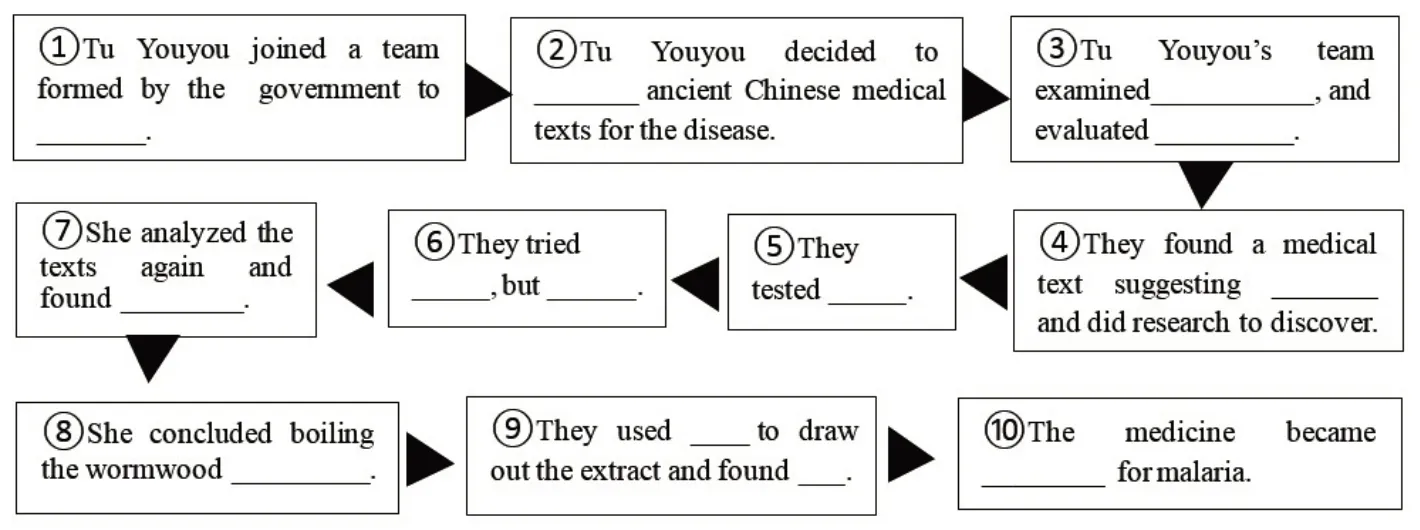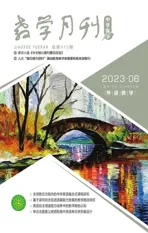科学素养培养视域下的高中英语阅读教学实践
——以“Tu Youyou Awarded Nobel Prize”为例
2023-06-29彭素飞浙江省遂昌中学
彭素飞|浙江省遂昌中学
科学素养(Science Literacy)是指一个人在从事某种工作时应具备的科学素质及其修养[1],包括科学精神、科学态度和科学价值观(最核心的内容),科学知识、技能、能力,科学行为和习惯[2]。《普通高中英语课程标准(2017年版2020年修订)》将“科学与技术”列为“人与社会”主题语境中的四个主题群之一,包括“社会进步与人类文明”“科技发展与信息技术创新,科学精神,信息安全”等子主题[3],强调培养学生的科学素养,帮助学生形成终身学习的能力。同时,对学生科学素养的考查也是高考的重要内容之一,如2022年1月普通高等学校全国统一招生考试英语浙江卷的阅读理解题C篇讲述的是关于锻炼与患老年痴呆疾病相关性的科学研究报告,读后续写题型要求学生按照明确的科学研究步骤续写故事。然而,目前的高中英语教学主要聚焦学生语言知识的学习和语言能力的培养,不太重视利用文本材料来培养学生的科学兴趣、科学方法和科学精神,导致学生容易成为“科盲”。下面以人教版普通高中教科书《英语》(以下简称“人教版教材”)选择性必修一Unit 1 People of Achievement 中的Reading and Thinking 板块阅读语篇“Tu Youyou Awarded Nobel Prize”为例,具体阐述科学素养培养视域下的阅读教学。“Tu Youyou Awarded Nobel Prize”是一篇关于屠呦呦获诺贝尔奖的新闻报道,展现了屠呦呦的科学成就、研究过程和科学精神。阅读语篇由四个段落组成:第一段直接点出屠呦呦获奖的原因和成就;第二、三段运用大量数据介绍了屠呦呦及其团队发现并提炼出青蒿素的过程,内容客观、准确,体现了科学的严谨性;第四段是屠呦呦的获奖感言和对屠呦呦的评价。
一、基于背景图式激活的科学兴趣激发
阅读是读者已有背景图式与新语篇提供的信息间互动的过程。因而,在读前环节,教师应设计活动,激活学生的已有背景图式,激发学生学习新内容的兴趣和期待。
笔者先呈现诺贝尔的头像和单元的主题图片,并提出问题Q1~Q15,让学生开展快问快答活动,激活学生对诺贝尔及诺贝尔奖的已有背景图式,激发学生的科学兴趣。
Q1:What nationality was Alfred Nobel?
Q2:What was he?
Q3:How many patents did he possess?
Q4:What did he do with his money?
Q5:Why did he set the Nobel Prizes?
Q6:How many kinds of the Nobel Prizes did he set?Q7:What are the prizes?
Q8:When is the awarding time?
Q9:Where is the awarding ceremony held?
Q10:What can a winner get?
Q11:Who is the lady in a purple dress?
Q12:What prize did she get?
Q13:Who is the gentleman awarding the prize?
Q14:What do male guests wear?
Q15:What do female guests wear?
接着,笔者播放屠呦呦获奖视频(内容包括诺贝尔的雕像、身着燕尾服的嘉宾、乐队的表演及嘉宾的热情鼓掌、身着亮紫色长套裙的屠呦呦接受瑞典国王卡尔十六世·古斯塔夫颁奖),让学生体验诺贝尔奖的颁奖流程,身临其境地感受诺贝尔奖颁奖的氛围、屠呦呦获奖带来的自豪感,从而促使学生对科学充满向往。
然后,笔者设计填空练习,引导学生梳理诺贝尔及诺贝尔奖的相关内容,让学生学会用英语来介绍诺贝尔及诺贝尔奖。填空练习如下:
Alfred Nobel, whose nationality was ____, is a great ____ with ____ patents and more than 90 factories in the world. He was very rich but he left his money to establish _____ to encourage the____of science,which is open to the whole world.There are six Nobel Prizes:____,___,____,___,___, ____. The awarding ceremony is a great occasion where the Swedish ___ awards the prizes including Nobel Prize ____ and golden ____. Male guests wear ____with white ties and tails while female guests wear floor-length evening____,of any style,or national dress.All people presenting are polite and respectful to the winners.
【设计说明】这一环节先通过快问快答活动激活学生的已有背景图式,激发学生对两位伟大科学家的兴趣,然后通过观看视频和梳理要点活动加深学生对诺贝尔及诺贝尔奖的了解,帮助学生学会用英语介绍诺贝尔及诺贝尔奖,有助于增强学生对科学的好奇心和求知欲,并产生亲近科学、体验科学、热爱科学、探索科学的情感。
二、基于主题相关内容拓展的科学知识学习
主题统领语篇的结构和内容。因而,在阅读教学中,教师应基于主题设计拓展活动,引导学生学习科学知识。
在学生熟悉诺贝尔及诺贝尔奖后,笔者先提出问题“Why was Tu Youyou awarded the Prize for Physiology or Medicine?”,帮助学习新单词artemisinin和malaria,为后面的语篇阅读扫清词汇障碍。
接着,笔者让学生阅读文章标题和文本第一段,并回答问题“What is artemisinin and what causes malaria?”,以使学生对artemisinin和malaria形成初步的认识。
然后,笔者呈现关于artemisinin和malaria的补充材料,加深学生对artemisinin和malaria的理解,让学生学习用英文介绍关于artemisinin和malaria的相关知识。补充材料如下:
Malaria has devastated humans for millennia and it continues to ravage civilizations across the planet.It is a disease caused by a parasite(寄生虫)known as Plasmodium(疟原虫).It gets into human blood through insects bites and is a disease that most often occurs in tropical (热带的) or subtropical regions of the world. Symptoms include fever, headache and vomiting. Malaria can quickly become life-threatening by disrupting the blood supply to vital organs. Early diagnosis and treatment reduces disease incidence,prevents deaths and cuts transmission.
Tu Youyou discovered artemisinin for treating malaria.An artemisinin-based drug combination is now the standard regimen for malaria.Tu Youyou led a team that transformed an ancient Chinese healing method into the most powerful antimalarial medicine currently available. Tu Youyou pioneered a new approach to malaria treatment that has benefited hundreds of millions of people and promises to benefit many times more.
【设计说明】这一环节旨在为学生提供了解疟疾和青蒿素的机会,以使学生了解疟疾的成因以及给人类健康带来的危害,进而深刻体会屠呦呦研究的伟大之处,真正领会科学发现带给人类的改变、健康和幸福。
三、基于研究问题解决的科学思维培养
问题是思维的起点,问题引导人们思考并产生解决问题的方法。基于研究问题解决的活动能够逐渐培养学生用创新思维去思考问题、用科学视角去分析问题和解决问题的意识。
在明确屠呦呦的成就、了解疟疾和青蒿素的相关知识后,笔者设计了exploring the research process、reporting the research process、summarizing the scientific stages三个活动,以使学生了解屠呦呦的研究过程,熟悉与科学研究相关的语言表达,以及归纳科学研究的步骤。
【exploring the research process】
笔者呈现屠呦呦发现青蒿素的过程图(如图1所示),让学生阅读语篇第二、三段并补充完整图1,旨在使学生探究科学家是如何进行研究并取得成功的,学习与科学研究相关的语言表达(如join a team、discover a new treatment、review ancient texts、examine medicine、evaluate plants、test the solution、try a new method、analyze the texts、conclude、use a standard treatment)。

图1 屠呦呦发现青蒿素的过程图
【reporting the research process】
为了让学生进一步巩固和运用与科学研究相关的常用语言表达,笔者设计口头报告任务让学生根据图1进行研究过程分享。口头报告任务如下:
Suppose you were a member of Tu Youyou’s team.You are going to share how you discovered artemisinin with some young researchers. You can add some connecting words to make your report smooth and logical.Remember to use the information in the flow chart above.Begin your report like this:
Good morning, ladies and gentlemen. It is my honor to share how we discovered artemisinin here.In 1967...
【summarizing the scientific stages】
在学生熟悉研究过程后,笔者引入人教版教材选择性必修二Unit 1 Science and Scientists中的Reading and Thinking 板块阅读语篇“Understand the Questioning Mind”,设计pair work 让学生根据研究过程归纳科学研究的步骤,促进学生科学思维的养成。pair work如下:
What stages do you think scientists must go through before they can finally solve their problems or have their discoveries?Match the following stages with the ten steps in the flow chart above:
Stage 1:finding a problem
Stage 2:making literature review
Stage 3:thinking of a solution
Stage 4:testing the solution/solutions
Stage 5:analyzing the result
Stage 6:drawing a conclusion
【设计说明】这一环节将学生的语言运用和尝试性运用贯穿语言学习的全过程,不仅有助于培养学生分类、归纳和表达的能力,而且有助于引导学生关注科学研究过程的独立性、逻辑性、清晰性和规范性,进而通过归纳科学研究的步骤,学习科学解决问题的方法,逐渐形成科学解决问题的意识和思维。
四、基于优秀品质挖掘的科学精神理解
科学家的成功不仅源于其科学的思维和解决方法,也归功于他们的科学道德和科学精神。因而,在学生对科学研究过程有一定了解后,教师应设计学习活动,引导学生通过挖掘科学家的优秀品质来理解科学家的科学精神。
笔者让学生以小组为单位讨论问题Q16和Q17,以使学生挖掘屠呦呦的优秀品质,体会屠呦呦的科学精神。
Q16:What good qualities does Tu Youyou possess? Find the adjectives describing her qualities in the news report and list the evidence to illustrate.
Q17:How do you understand the quote“Try not to become a man of success but rather try to become a man of value.”?
针对Q16,学生不仅找出语篇中的关键词汇committed 和patient,还在讨论中提出更多描述屠呦呦优秀品质的词汇,如knowledgeable、enthusiastic、brave、determined、resilient、selfless、cooperative、patriotic等。在此基础上,笔者以committed、patient、brave、cooperative、patriotic为关键词设计表1(斜体部分为学生所填内容),让学生从语篇中找出信息来支撑屠呦呦的优秀品质,深刻体会屠呦呦所传递的科学精神。

表1 科学精神及其支撑性信息
针对Q17,大部分学生认为我们都应为世界作出自己的贡献。在此基础上,笔者分享了自己的感言“Scientists do great contributions to the world and promote the advancement of mankind.We may not become successful persons like them,but we can work enthusiastically,determinedly and scientifically like a scientist, thus benefiting ourselves, people around us and even the whole world in the future.”。
【设计说明】语篇有大量展现屠呦呦优秀品质的信息,包括丰富的数据、翔实的研究过程和屠呦呦的感言。教师引导学生通过挖掘屠呦呦的优秀品质,体会其科学精神,有助于锻炼学生用事实表达的能力,帮助学生逐渐理解求实、实证、探索、创新和合作等科学精神的内涵。
五、基于思考和实践的科学行为养成
问题的思考能促进学生更深入地学习,动手实践有助于提升学生自主解决问题的能力,从而帮助学生养成用科学方法和步骤去解决问题的习惯。
笔者设计先让学生阅读语篇“The Problems of Snakes”并梳理解决问题的步骤,然后以“How I Solved…Like A Scientist”为题写一个解决类似问题的报告的课后活动。课后活动如下:
Step 1:Read the passage“The Problems of Snakes”to further understand the scientific stages and qualities and then list the stages how she solved her problem scientifically.
Step 2:Write a report with the title“How I Solved…Like A Scientist”following the scientific stages.
【设计说明】用英语写一份研究报告,汇报自己在日常生活中如何按照科学步骤和方法去解决问题,可以帮助学生深入理解如何像科学家一样解决问题,进而养成科学行为。同时,这一课后活动也可以引导学生在探究语篇意义的各种语言活动中学习和尝试使用语篇主题情境中的语言,做到纲举目张,激发学生的学习兴趣和对深层、广阔意义的追求[4]。
科学知识的增长有利于丰富学生的背景图式,拓宽学生的视野和思路,提振学生阅读科普文章的信心;科学方法的学习可以让学生在面对问题时,有解决问题的意识,并能理性地分析困难的起因,科学地思考如何有效解决;科学思维和科学精神的浸润可以让学生更加富有灵性和韧性,学习也更加积极向前,从而实现文化育人。在英语阅读教学中融入科学素养的培养,让学生走进科学、走进科学研究,领略科学魅力,有助于在潜移默化中拓宽学生的英语学习渠道,打开学生的英语学习视野,帮助学生形成科学思维,提升学生的文化意识,培养有情怀、有视野、有能力的时代新人,为学生未来参与知识创新和科技创新,更好地适应世界多极化、经济全球化和社会信息化奠定基础[5]。在日常教学中,教师不仅应充分利用教材中关于“科学与技术”主题群的内容,激发学生的科学兴趣,为学生普及科学知识、传授科学方法、展现科学精神的内容,还应开展以科学素养培养为主体的窄式阅读,选编高考试卷和课外阅读中的科普类文章让学生进行集中阅读,帮助学生熟悉科普类文章的特点和科学研究的过程,提升学生的科学素养,提高学生的英语语言能力,实现英语学习工具性与人文性的有效融合。□◢
